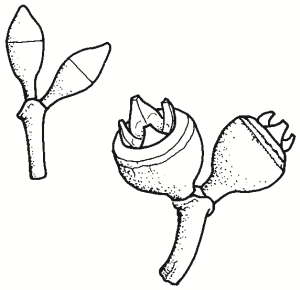Family:
Myrtaceae
Eucalyptus viminalis
Manna Gum
Other Names: Ribbon Gum, White Gum.
First Nations Name(s): Binnap, Beb.

Name Origin:
viminalis — from Latin viminalis, bearing long flexible twigs or osier bearing, supposedly referring to resemblance of adult leaves to those of Osier Willow. Common name refers to manna (white sugary exudate) which falls from young foliage.
Regional Subspecies:
Similar Species:
Distinguished from Candlebark (E. rubida) mainly by its juvenile foliage, buds and fruit.
Occurrence:
Regional:
Catchments and districts with higher rainfall, east of the Hume Highway.
Australia:
Qld, NSW, Vic, Tas, SA.
Habitat:
Grassy woodland or forest on fertile loamy soils.
Habit:
Tall upright tree to 30 m high (sometimes to 50 m), with narrow glossy green leaves.
Site Preference:
Moist, well-drained soil. Tolerates frost, snow and some flooding. Drought and fire tolerance depend on provenance (locality). Trees from lower rainfall areas more drought tolerant than those from higher rainfall areas.
Characteristics:
Fast-growing. Saplings respond to fertiliser.
Flowering:
White, Jan-May (mainly Feb-Mar). Not prolific.
Seed Collection:
Early Jul to late Mar. Monitor capsules as seeds released 3-8 weeks after maturity. Heavy seeding every 2-3 years.
Propagation:
From seed (± 350 seeds per gram). Optimum germination temperature 27°C.
Regeneration:
From seed, particularly in absence of competitive exotic grasses or weeds, during wet summers. Coppices from cut stumps, and regenerates well from lignotubers after fire. Establishes very well when direct seeded.
VALUES:
Shade & Shelter:
Useful high-level cover in windbreaks.
Land Protection:
Useful for controlling underground seepage and stabilising landslip areas, as deep roots use large volumes of ground-water.
Wildlife:
Excellent habitat. Foliage is major koala forage. Gum is food for possums, particularly the Yellow-bellied Glider and Sugar Glider. The Yellow-bellied Glider bites grooves in bark to reach sapwood, as gum released to heal wound is favoured food. Nectar-rich flowers are a food source for birds such as honeyeaters, including the Red Wattlebird, Yellow-tufted Honeyeater and White-plumed Honeyeater. Hollows are valuable nesting sites for a range of native birds and mammals.
Fuel:
Useful, although fast-burning.
Timber:
Light pink or pale yellow, straight-grained and moderately coarse-textured. Moderately strong but not durable. Density about 750 kg/m3. Used for building framing, flooring, paneling, joinery and pulp for container board.
First Nations:
‘Manna’ pellets gathered from ground and taken as a mild laxative. Flat shields and ‘tarnuks’ or water containers hollowed out from trunk burls, made from timber. Leaves laid on fires to smoke out fever. Bark and leaves moistened to treat sore eyes. Leaves consumed as remedy for diarrhoea.
Ornamental:
Attractive specimen or shade for large gardens and parks.
Other:
Leaves produce dyes ranging in colour depending on mordants used.
